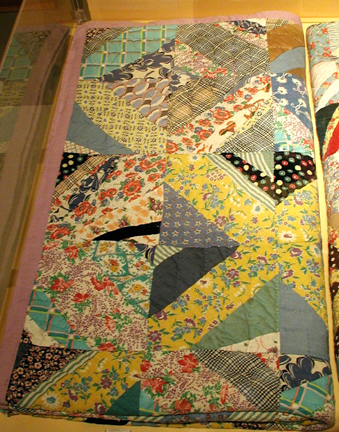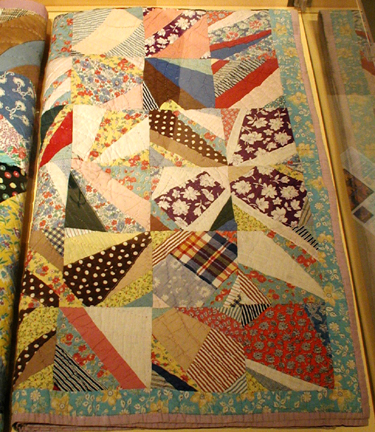|
 Picking cotton, feeding the chickens, walking to school and learning to sew were ordinary tasks for a young farm girl in rural north Alabama in the late 1920’s. By age 19, Nonnie Hudson had a keen interest in extending her sewing skills into making quilts. Her sweetheart, Verlon Williams, mentioned her pretty needlework and quilting in letters he wrote to Nonnie in 1928 and early 1929. By the time they were married in October, 1929 Nonnie had quilted enough cover to satisfy her “Maw.” As their family grew, piecing functional utilitarian string quilts was a regular evening pastime. By day, Nonnie worked alongside Verlon and their children old enough to help on the farm. Picking cotton, feeding the chickens, walking to school and learning to sew were ordinary tasks for a young farm girl in rural north Alabama in the late 1920’s. By age 19, Nonnie Hudson had a keen interest in extending her sewing skills into making quilts. Her sweetheart, Verlon Williams, mentioned her pretty needlework and quilting in letters he wrote to Nonnie in 1928 and early 1929. By the time they were married in October, 1929 Nonnie had quilted enough cover to satisfy her “Maw.” As their family grew, piecing functional utilitarian string quilts was a regular evening pastime. By day, Nonnie worked alongside Verlon and their children old enough to help on the farm.
School was a major focus for each child. Attendance was no problem. The kids were motivated to rise early, complete their chores and be ready for the school bus. Missing the bus meant having to stay home and work. Therefore, catching the bus was a given. Nonnie and Verlon maintained a goal of helping their nine children go to college. Management and hard work were taught and practiced. Farm work and gardening occupied Nonnie’s days during spring, summer and fall. Yet she found time to grow beautiful, colorful flowers. Nonnie frequently shared flower cuttings and quilt patterns with neighbors and visitors far and wide. Making every moment count contributed to her ability to accomplish work at home and make time for church and community service projects.
 Nonnie’s patchwork string quilts are an array of cotton scraps and feed sack material. Even though well used, the quilts are still quite sturdy. She typically machine pieced random patchwork scraps or string pieced on paper foundation squares cut from Sears Roebuck catalogs. Any sewing, patching and quilting was relegated to evenings and cold weather. Flavin, the youngest child, remembers playing under a quilt frame in the mid-1950’s at Dowling School. Nonnie coordinated quiltings to raise funds for the school’s PTA endea Nonnie’s patchwork string quilts are an array of cotton scraps and feed sack material. Even though well used, the quilts are still quite sturdy. She typically machine pieced random patchwork scraps or string pieced on paper foundation squares cut from Sears Roebuck catalogs. Any sewing, patching and quilting was relegated to evenings and cold weather. Flavin, the youngest child, remembers playing under a quilt frame in the mid-1950’s at Dowling School. Nonnie coordinated quiltings to raise funds for the school’s PTA endea vors. Years later Nonnie taught Flavin to quilt. It was not the automatic mother-teach-daughter occurrence, as one might expect. Nonnie was never one to waste time. She waited until completely convinced Flavin’s interest in quilting was genuine before teaching her the rudiments of patchwork. Today, Nonnie’s quilts belong to children and grandchildren all across the USA. Her quilts were made sturdy, stitched well and are cared for by those who appreciate her making time to piece cover. vors. Years later Nonnie taught Flavin to quilt. It was not the automatic mother-teach-daughter occurrence, as one might expect. Nonnie was never one to waste time. She waited until completely convinced Flavin’s interest in quilting was genuine before teaching her the rudiments of patchwork. Today, Nonnie’s quilts belong to children and grandchildren all across the USA. Her quilts were made sturdy, stitched well and are cared for by those who appreciate her making time to piece cover.
|



